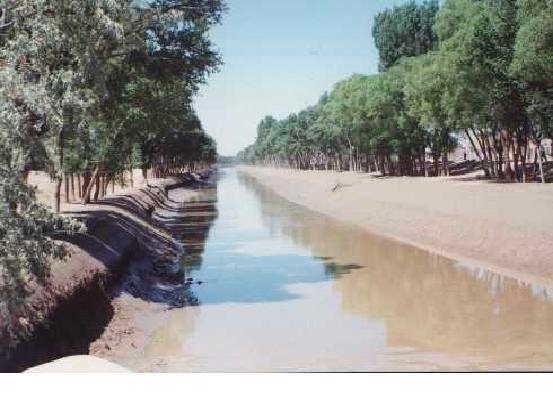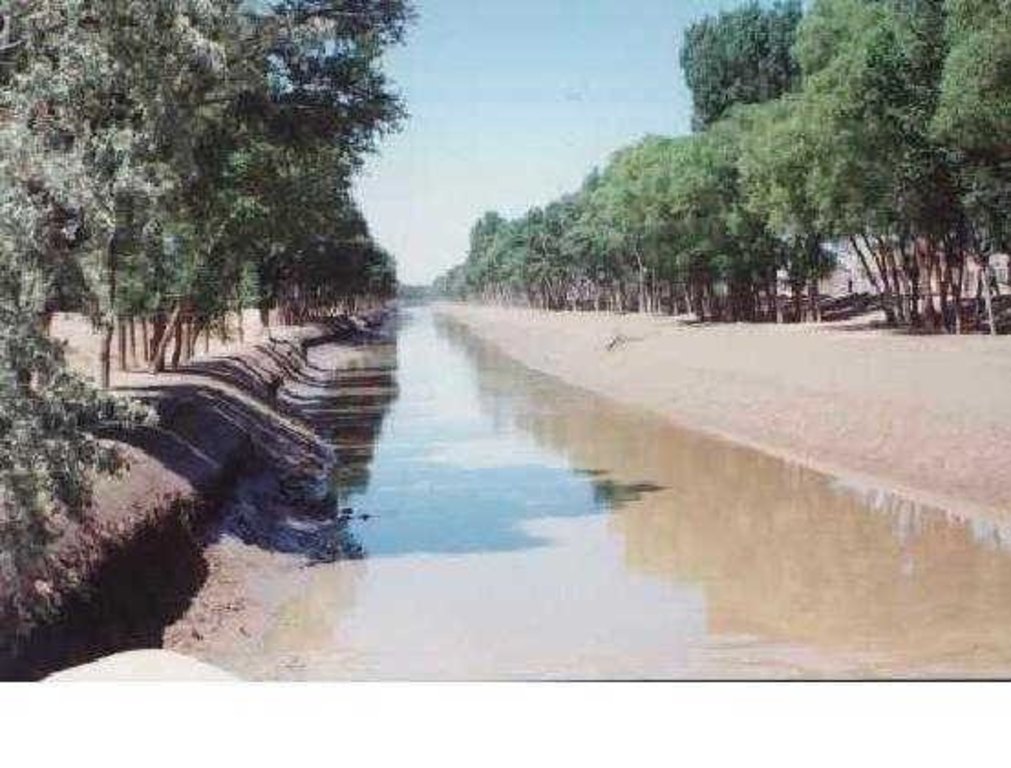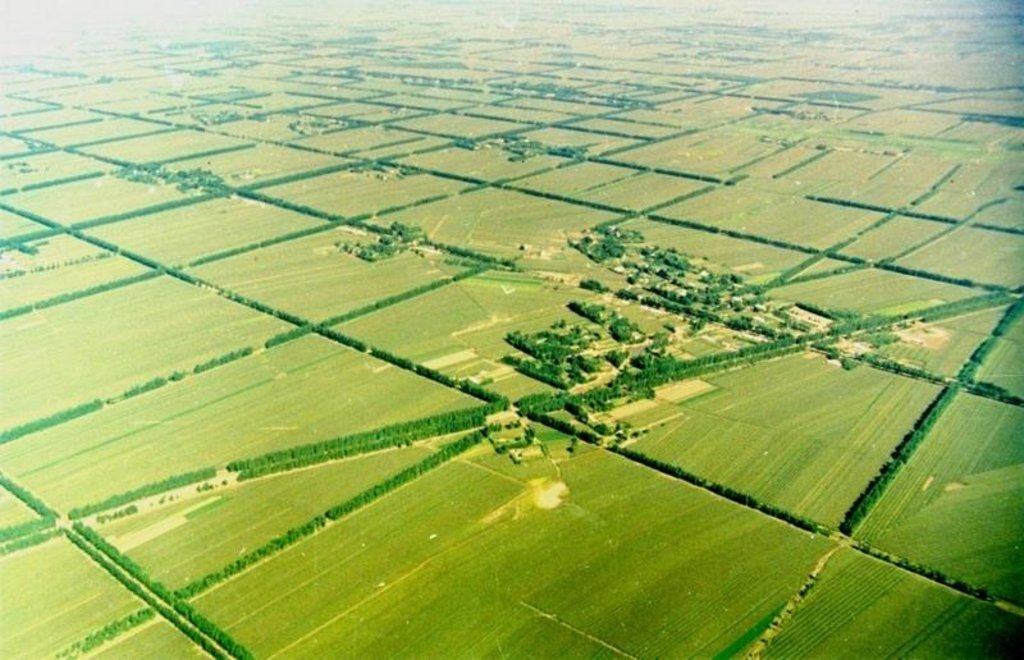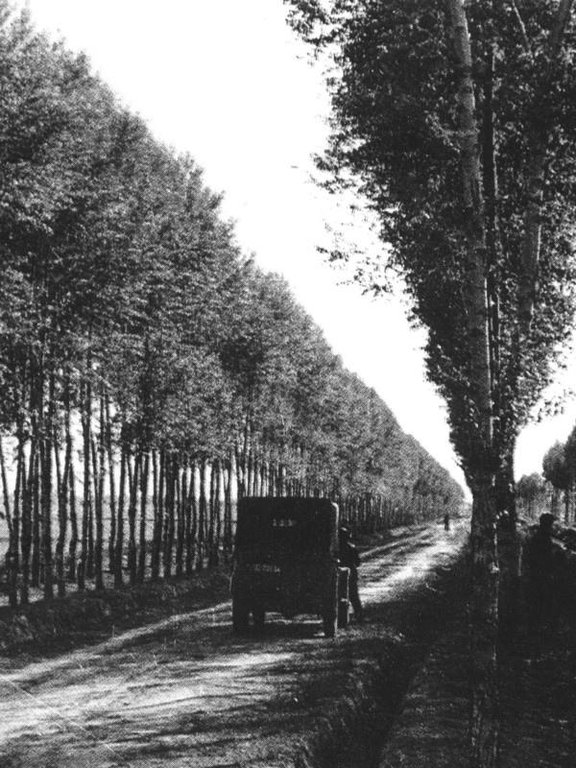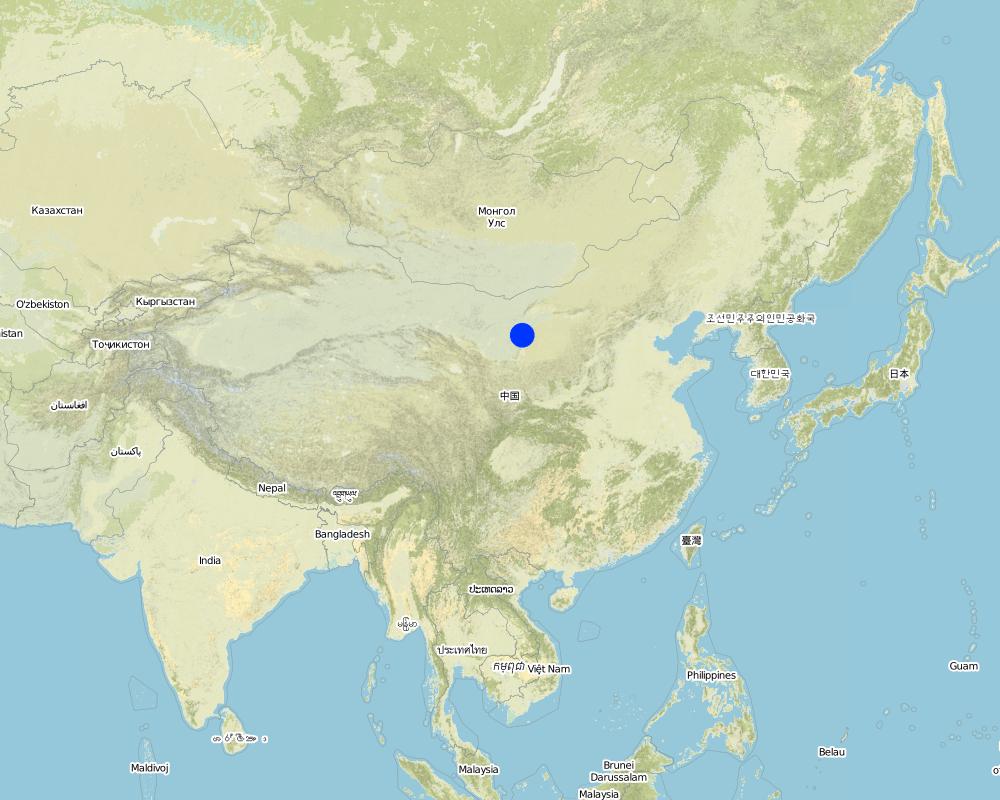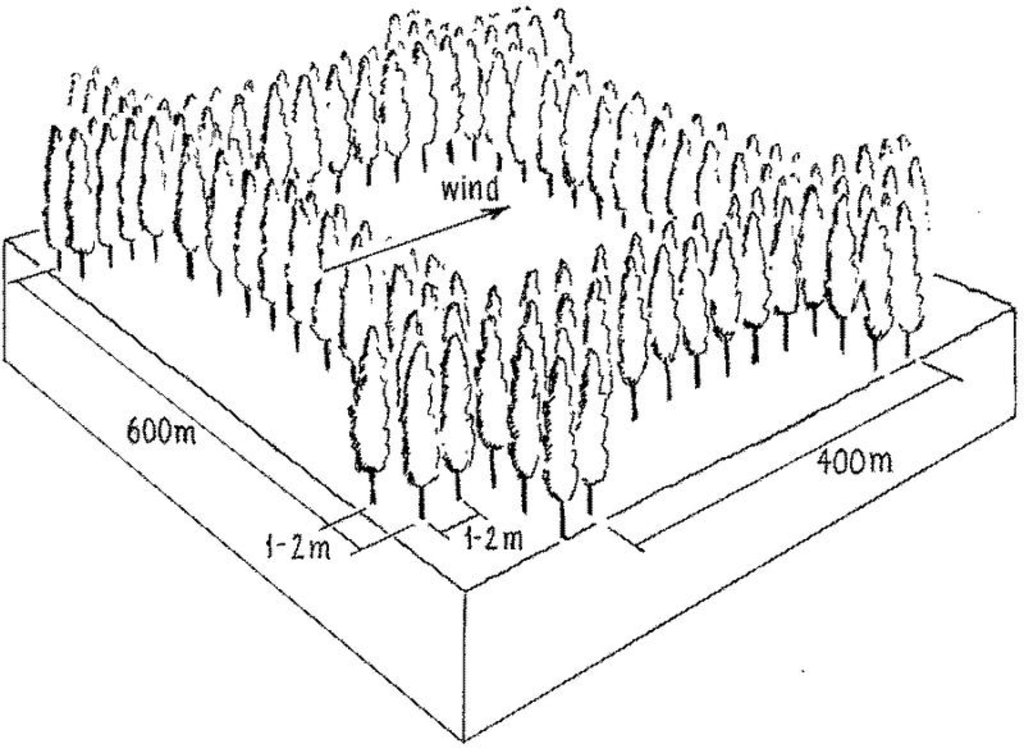Shelterbelts for farmland in sandy areas [Хятад]
- Шинийг нээх:
- Шинэчлэх:
- Эмхэтгэгч: Meili WEN
- Хянан тохиолдуулагч: –
- Хянагчид: David Streiff, Deborah Niggli
Farmland shelter belt
technologies_1366 - Хятад
Бүлгүүдийг үзэх
Бүгдийг дэлгэх Бүгдийг хаах1. Ерөнхий мэдээлэл
1.2 Технологийг үнэлэх, баримтжуулах ажилд хамаарах мэдээлэл өгсөн хүмүүс, байгууллагуудын холбоо барих мэдээлэл
ГТМ мэргэжилтэн:
Wang Dogmei
Хятад
Технологи баримтжуулах/үнэлэх ажилд дэмжлэг үзүүлсэн төслийн нэр (шаардлагатай бол)
Book project: where the land is greener - Case Studies and Analysis of Soil and Water Conservation Initiatives Worldwide (where the land is greener)Технологи баримтжуулах/үнэлэх ажилд дэмжлэг үзүүлсэн байгууллага(ууд)-ын нэр (шаардлагатай бол)
GEF/OP12 Gansu Project (GEF/OP12 Gansu Project) - Хятад1.3 ВОКАТ-аар баримтжуулсан өгөгдлийг ашиглахтай холбоотой нөхцөл
Мэдээллийг хэзээ (газар дээр нь) цуглуулсан бэ?
20/05/2002
Эмхэтгэгч болон гол мэдээлэгч хүн(хүмүүс) WOCAT аргачлалаар баримтжуулсан мэдээллийг ашиглахтай холбоотой нөхцлийг хүлээн зөвшөөрсөн:
Тийм
1.5 ГТМ-ийн Арга барилын талаархи санал асуулгын(д) суурь мэдээлэл
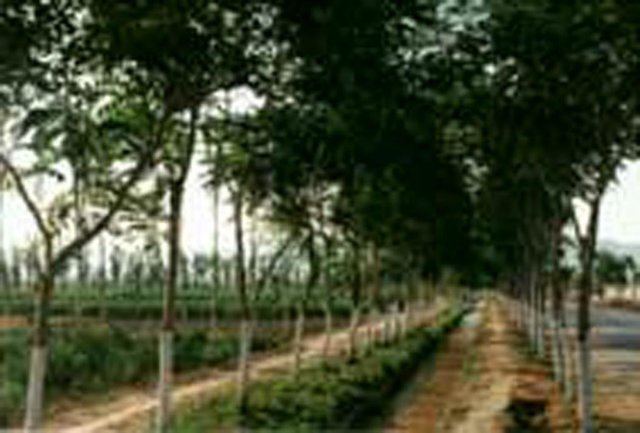
Shelter Belt [Хятад]
The shelter belt is a strip or a row of trees planted in a farmland as a wind barrier to protect crops and reduce wind erosion.
- Эмхэтгэгч: Meili WEN
2. ГТМ Технологийн тодорхойлолт
2.1 Технологийн товч тодорхойлолт
Технологийн тодорхойлолт:
Belts of trees, planted in a rectangular grid pattern or in strips within, and on the periphery of, farmland to act as windbreaks.
2.2 Технологийн дэлгэрэнгүй тодорхойлолт
Тодорхойлолт:
Shelterbelts to protect cropland are a specific type of agroforestry system comprising certain tall growing tree species. Such shelterbelts around farmland help reduce natural hazards including sandstorms, wind erosion, shifting sand, droughts and frost. They also improve the microclimate (reduced temperature, wind speed, soil water loss and excessive wind-induced transpiration) and create more favourable conditions for crop production. Thus the establishment of shelterbelts plays a crucial role in the sandy drylands that are affected by wind and resultant desertification
especially during winter and spring. Where there is irrigation, the shelterbelts protect the infrastructure from silting-up with wind-borne sediment.
Strips of tall growing species (15-25 m) of poplar (Populus spp.) or willow (Salix spp.) were originally (from 1960s onwards) planted in a 400 by 600 m rectangular grid pattern within extensive areas of cropland, with an extra belt of windbreaks on the windward side (against the prevailing wind). Generally, the distance effectively protected is 15-25 times the tree height. Strips are of variable width, consisting of 2-5 tree lines (1-3 m apart) with trees planted every 1-2 m within the lines. Selective felling is used to maintain adequate growing space and the protective effect of the trees.
The impact of the shelterbelts depends on the planting pattern of the trees (the format of strips and grids), the orientation of the shelterbelts in relation to the wind, the spacing between, and the width of each strip and the type of trees planted. The specific design is primarily based on preventing the negative effects of wind, but depends also on local conditions such as the layout of the land, the location of the roads, farm boundaries and irrigation canals. Ideally the tree strips are perpendicular to the prevailing wind direction, and the angle between the strip and the prevailing wind is never less than 45 degrees. The structure of the strips determines the way the wind is controlled, ranging from blocking the wind
to letting it diffuse through semi-permeable shelterbelts. The best effect is achieved if the wind is not blocked entirely, as this can cause turbulence.
The ownership of the land and the shelterbelts still rests with the state, but management has been more and more transferred to individual households. On condition that the impact of the shelterbelt is not affected, the local forestry agencies now allow some felling of mature trees - on a rotational and selective basis, for timber and firewood. Pine trees (Pinus sylvestris var. mongolica and P. tabulaeformis), which command high value as timber for construction, and fruit (and cash) trees like the apricot tree (Prunus armeniace) are increasingly used.
2.3 Технологийн гэрэл зураг
2.5 Энэ үнэлгээнд хамрагдсан технологийг хэрэгжүүлсэн улс орон/ бүс нутаг/ байршил
Улс:
Хятад
Улс/аймаг/сум:
Inner Mongolia Autonomous Region
Map
×2.6 Хэрэгжсэн хугацаа
Байгуулсан тодорхой оныг мэдэхгүй бол баримжаа хугацааг тодорхойл:
- >50 жилийн өмнө (уламжлалт)
2.7 Технологийн танилцуулга
Технологийг хэрхэн нэвтрүүлснийг тодорхойл:
- Гадны төсөл/хөтөлбөрийн дэмжлэгтэйгээр
Тайлбар (төслийн төрөл г.м.):
USA and domestic.
3. ГТМ технологийн ангилал
3.1 Технологийн үндсэн зорилго (ууд)
- гамшгийн эрсдлийг бууруулах
3.2 Технологи нэвтрүүлсэн газрын одоогийн газар ашиглалтын хэлбэр(үүд)

Холимог (тариалан/бэлчээр/мод), үүнд. ХАА-н ойжуулалт
- ХАА-н ойжуулалт
Гол бүтээгдэхүүн/ үйлчилгээ:
major cash crop: maize/wheat
Тайлбар:
Major land use problems (compiler’s opinion): Strong winds in the winter and spring result in serious natural hazards including sand storms, sand encroachment and wind erosion, while dry and hot winds in the summer increase transpiration leading to plant stress and reduced crop yields.
Major land use problems (land users’ perception): Low yield and intensive wind blow in winter and spring.
Хэрэв технологи нэвтрүүлснээр газар ашиглалтад өөрчлөлт гарсан бол технологи нэвтрүүлэхээс өмнө байсан газар ашиглалтын хэлбэрийг тодорхойлно уу:
Cropland: Ca: Annual cropping
3.3 Газар ашиглалтын тухай нэмэлт мэдээлэл
Технологи хэрэгжүүлсэн газрын усан хангамж:
- Байгалийн/усалгаатай арга хосолсон
Жилд ургамал ургах улирлын тоо:
- 1
Тодорхойлно уу:
Longest growing period in days: 150Longest growing period from month to month: May - Sep
3.4 Технологи ГТМ-ийн аль бүлэгт хамаарах вэ
- ХАА-н ойжуулалт
- Салхины хамгаалалтын ойн зурвас
3.5 Технологийн хамрах талбай
Технологи өргөн дэлгэрсэн эсхийг тодорхойл:
- газар дээр жигд тархсан
Технологи газар нутгийн хэмжээнд жигд тархсан бол түүний эзлэх талбайг дундажаар тооцож тэмдэглэ:
- 100-1,000 км2
Тайлбар:
Total area covered by the SLM Technology is 500 m2.
Total SWC Technology area is not clear. This technology area data is from Inner Mongolia forest department. Inner Mongolia autonomy region forest statistic data, 1987, P75. Technology beginning year is from: Water and soil conservation bureau, Yellow River irrigation works committee of Department of water and electricity. Water and soil conservation economy benefit thesis collecting,1987, P45-47.
3.6 Технологийг бүрдүүлэх ГТМ арга хэмжээ

Ургамлын арга хэмжээ
- V1: Мод ба бут, сөөг

Менежментийн арга хэмжээ
- М1: Газар ашиглалтын хэлбэрийг өөрчлөх
Тайлбар:
Main measures: vegetative measures
Type of vegetative measures: aligned: -against wind
3.7 Технологид харгалзах газрын доройтлын төрөл

хөрс салхиар эвдрэх
- Et: Хөрсний гадаргын зөөгдөл
- Eo: Салхины элэгдлийн дам нөлөө

усны доройтол
- Ha: Хуурайшилт
Тайлбар:
Main type of degradation addressed: Et: loss of topsoil, Eo: offsite degradation effects, Ha: aridification
Main causes of degradation: deforestation / removal of natural vegetation (incl. forest fires), poverty / wealth (Lack of captial)
Secondary causes of degradation: overgrazing, education, access to knowledge and support services (Lack of knowledge), Lack of enforcement of legislat./authority
3.8 Газрын доройтлоос урьдчилан сэргийлэх, сааруулах ба нөхөн сэргээх
Газрын доройтолтой холбоотойгоор Технологи ямар зорилго тавьсан болохыг тодорхойл:
- Газрын доройтлыг бууруулах
Тайлбар:
Main goals: mitigation / reduction of land degradation
4. Техникийн нөхцөл, хэрэгжүүлсэн үйл ажиллагаа, материал ба зардал
4.1 Технологийн техник зураг
4.2 Техникийн үзүүлэлт/ техникийн зургийн тайлбар
Overview of the shelterbelt layout.
Insert 1: Planting scheme: shelterbelts compromise 2-5 tree lines forming the windbreak about 5-15 m wide and 15-25 m high.
Insert 2: Rectangle grid layout of shelterbelts. Spacing of the rows is denser against the prevailing wind.
Technical knowledge required for field staff / advisors: moderate
Technical knowledge required for land users: low
Main technical functions: increase / maintain water stored in soil, reduction in wind speed, protection from wind erosion, protection from sand encroachment, protection of crops from mechanical damage, reduction in evaporation loss
Secondary technical functions: increase in organic matter
Aligned: -against wind
Vegetative material: T : trees / shrubs
Trees/ shrubs species: Poplars (Populus spp.), willows (Salix spp.), increasingly also pine (Pinus sylvestris var. Mongolic
4.3 Материал болон зардалд хамаарах ерөнхий мэдээлэл
Үнэ өртөг, оруулсан хувь нэмрийг хэрхэн тооцсоныг тодорхойл:
- Технологийн нэгж тус бүр
Талбайн хэмжээ ба нэгжийг тодорхойл:
ha
Үнэ өртөгийг тооцоход ашигласан мөнгөн нэгж:
- Америк доллар
Хөлсний ажилчны нэг өдрийн цалингийн хэмжээг тодорхойлно уу:
1.20
4.4 Бий болгох үйл ажиллагаа
| Үйл ажиллагаа | Арга хэмжээний төрөл | Хугацаа | |
|---|---|---|---|
| 1. | 1 Planning / designing of shelterbelt. | Ургамлын | |
| 2. | 2 Selection and collection of trees seedlings. | Ургамлын | |
| 3. | 3 Clearing and preparing land for planting of shelterbelt in | Ургамлын | late autumn and spring |
| 4. | 3 Clearing and preparing land for planting of shelterbelt in | Ургамлын | |
| 5. | 4 Pits for planting the seedlings are dug | Ургамлын | 4 Pits for planting the seedlings are dug |
| 6. | 5 Tree seedlings are planted | Ургамлын | late spring |
| 7. | 6 After planting each seedling is watered for up to two years. | Ургамлын |
4.5 Бий болгоход шаардагдсан зардал, хөрөнгийн өртөг
| Зардлын нэр, төрөл | Хэмжих нэгж | Тоо хэмжээ | Нэгжийн үнэ | Зардал бүрийн нийт өртөг | Нийт дүнгээс газар ашиглагчийн төлсөн % | |
|---|---|---|---|---|---|---|
| Хөдөлмөр эрхлэлт | Mainly collection and planting | ha | 79.0 | 1.2 | 94.8 | |
| Тоног төхөөрөмж | tools | ha | 1.0 | 5.0 | 5.0 | 100.0 |
| таримал материал | tree seedlings | ha | 1.0 | 25.0 | 25.0 | |
| Технологи бий болгох нийт үнэ өртөг | 124.8 | |||||
Хэрэв газар ашиглагч нийт зардлын 100% -иас бага хэсгийг төлсөн бол хэн голлох зардлыг гаргасан бэ:
USA and domestic projects
Тайлбар:
Duration of establishment phase: 36 month(s)
4.6 Арчилгаа/ урсгал үйл ажиллагаа
| Үйл ажиллагаа | Арга хэмжээний төрөл | Хугацаа/ давтамж | |
|---|---|---|---|
| 1. | Watering | Ургамлын | after planting /timely |
| 2. | Pruning of trees. | Ургамлын | |
| 3. | Pest and disease control within shelterbelt. | Ургамлын | |
| 4. | Intermediate/ selective tree felling. | Ургамлын |
4.7 Арчилгаа/урсгал ажилд шаардагдсан зардал, хөрөнгийн өртөг (нэг жилд)
| Зардлын нэр, төрөл | Хэмжих нэгж | Тоо хэмжээ | Нэгжийн үнэ | Зардал бүрийн нийт өртөг | Нийт дүнгээс газар ашиглагчийн төлсөн % | |
|---|---|---|---|---|---|---|
| Хөдөлмөр эрхлэлт | Watering and Pruning | ha | 7.0 | 1.2 | 8.4 | 100.0 |
| таримал материал | tree seedling | ha | 1.0 | 3.0 | 3.0 | 100.0 |
| Технологийн арчилгаа/урсгал үйл ажиллагаанд шаардагдах нийт үнэ өртөг | 11.4 | |||||
Тайлбар:
The costs are calculated according to current standards/costs. The original planting is paid for by the state: replanting
and maintenance are the responsibility of the land user. If pines are the species of choice for re-planting, the cost
is considerably more than that shown above (which relates to poplar and willow).
Assuming: shelterbelts of 600 m by 400 m; each strip has 5 lines of trees (3 m apart), 2 m between trees within lines: resulting in 104 trees/ha, including the cropland between the strips (density within strips is 1666 trees/ha). Labour for establishment (104 trees): Land preparation, planting 10 days and 15 days for watering, weeding, etc (for first 3 years).
4.8 Зардалд нөлөөлж байгаа хамгийн чухал хүчин зүйл
Өртөг, зардалд нөлөөлөх гол хүчин зүйл:
The most important factors to affect the costs are seedlings (No.) and machine.
5. Байгаль ба нийгмийн нөхцөл
5.1 Уур амьсгал
Жилийн нийлбэр хур тундас
- < 250 мм
- 251-500 мм
- 501-750 мм
- 751-1,000 мм
- 1,001-1,500 мм
- 1,501-2,000 мм
- 2,001-3,000 мм
- 3,001-4,000 мм
- > 4,000 мм
Жилийн дундаж хур тунадас (хэрэв мэдэгдэж байвал), мм:
430.00
Агро-уур амьсгалын бүс
- хагас хуурай
5.2 Гадаргын хэлбэр
Дундаж налуу:
- хавтгай (0-2 %)
- бага зэрэг налуу (3-5 %)
- дунд зэрэг налуу (6-10 % )
- хэвгий (11-15 %)
- налуу (16-30 %)
- их налуу (31-60 % )
- эгц налуу (>60 %)
Гадаргын хэлбэр:
- тэгш өндөрлөг / тал
- нуруу
- уулын энгэр
- дов толгод
- бэл
- хөндий
Өндрийн бүслүүр:
- 0-100 д.т.д. м.
- 101-500 д.т.д. м.
- 501-1,000 д.т.д м.
- 1,001-1,500 д.т.д м.
- 1,501-2,000 д.т.д м.
- 2,001-2,500 д.т.д. м.
- 2,501-3,000 д.т.д. м.
- 3,001-4,000 д.т.д м.
- > 4,000 д.т.д. м.
Технологи дараах асуудалд хандсан эсэхийг тодорхойл:
- хамааралгүй
5.3 Хөрс
Хөрсний дундаж зузаан:
- маш нимгэн (0-20 см)
- нимгэн (21-50 см)
- дунд зэрэг зузаан (51-80 см)
- зузаан (81-120 cм)
- маш зузаан (>120 cм)
Хөрсний бүтэц (өнгөн хөрс):
- бүдүүн/ хөнгөн (элсэрхэг)
Өнгөн хөрсөнд агуулагдах ялзмаг:
- дунд (1-3 % )
Боломжтой бол хөрсний бүрэн тодорхойлолт, боломжит мэдээллийг өгнө үү, жишээ нь хөрсний төрөл, хөрсний урвалын орчин/хүчиллэг байдал, катион солилцох чадавхи, азотын хэмжээ, давсжилт г.м.
Soil fertility: low -medium
Soil drainage / infiltration: good
Soil water storage capacity: medium
5.6 Технологи нэвтрүүлсэн газар ашиглагчдын тухай мэдээлэл
Үйлдвэрлэлийн системийн зах зээлийн чиг баримжаа:
- холимог (амь зуух/ худалдаа наймаа
Бусад эх үүсвэрээс олох орлого:
- Нийт орлогын 10-50 %
Чинээлэг байдлын түвшин:
- дундаж
Механикжилтын түвшин:
- механикжсан / мотортой
Газар ашиглагчдын бусад шинж чанарыг тодорхойл:
Population density: 10-50 persons/km2
Annual population growth: 1% - 2%
80% of the land users are average wealthy and own 35% of the land.
Off-farm income specification: farmers benefit from the shelterbelts as a source of off-farm income, through fodder, timber and firewood
5.7 Технологи нэвтрүүлсэн газар ашиглагчийн өмчилж буй, эзэмшиж буй, түрээсэлж буй эсвэл ашиглаж буй (ашиглах эрх) газрын талбай
- < 0.5 га
- 0.5-1 га
- 1-2 га
- 2-5 га
- 5-15 га
- 15-50 га
- 50-100 га
- 100-500 га
- 500-1,000 га
- 1,000-10,000 га
- > 10,000 га
5.8 Газар эзэмшил, газар ашиглах эрх, ус ашиглах эрх
- communal/state
- individual (see Annex T3 for remark)
- individual (see Annex T3 for remark)
6. Үр нөлөө ба дүгнэлт
6.1 Технологийн талбайд үзүүлсэн нөлөө
Нийгэм-эдийн засгийн үр нөлөө
Үйлдвэрлэл
газар тариалангийн үйлдвэрлэл
модлогийн бүтээмж
үйлдвэрлэлийн газар
Тайлбар/ тодорхой дурьдах:
width of the shelterbelt
Орлого, зарлага
тухайн аж ахуйн орлого
Нийгэм-эдийн засгийн бусад үр нөлөө
off-farm income
Тайлбар/ тодорхой дурьдах:
extra timber and firewood
Crop production
Тайлбар/ тодорхой дурьдах:
Trees in competition with crops for solar radiation, fertilizer, and water
Нийгэм-соёлын үр нөлөө
маргааныг шийдвэрлэх
Loss of Food per agricultural land
Тайлбар/ тодорхой дурьдах:
shelterbelts of trees are not a direct source of food
Экологийн үр нөлөө
Усны эргэлт/ илүүдэл
гадаргын урсац
ГТМ хэрэгжихээс өмнөх тоо хэмжээ:
8
ГТМ хэрэгжиснээс хойшхи тоо хэмжээ:
0
Хөрс
хөрсний чийг
хөрсөн бүрхэвч
хөрс алдагдах
ГТМ хэрэгжихээс өмнөх тоо хэмжээ:
4
ГТМ хэрэгжиснээс хойшхи тоо хэмжээ:
2
Уур амьсгал болон гамшгийн эрсдлийг бууруулах
салхины хурд
Экологийн бусад үр нөлөө
sand encroachment
microclimate for crops
Тайлбар/ тодорхой дурьдах:
regulating temperature, increasing humidity
conservation/maintenance of soil fertility
6.4 Өртөг ба ашгийн шинжилгээ
Арчилгаа/урсгал зардалтай харьцуулахад ямар ашиг өгсөн бэ (газар ашиглагчийн бодлоор)?
Богино хугацаанд эргэн төлөгдөх байдал:
бага зэрэг эерэг
Урт хугацаанд эргэн төлөгдөх байдал:
маш эерэг
6.5 Технологи нэвтрүүлэлт
- жишээ/ туршилт
Боломжтой бол, тоогоор илэрхийл (өрхийн тоо эсвэл бүрхэх талбай):
40 households in an area of 100-1000km^2 (10-50 persons/km^2)
Технологи нэвтрүүлсэн хүмүүсээс хэд нь өөрийн хүчээр технологийг хэрэгжүүлсэн бэ, өөрөөр хэлбэл гадны тусламж дэмжлэг авалгүйгээр?
- 0-10%
Тайлбар:
100% of land user families have adopted the Technology with external material support
40 land user families have adopted the Technology with external material support
Comments on acceptance with external material support: estimates
Comments on spontaneous adoption: estimates
There is no trend towards spontaneous adoption of the Technology
Comments on adoption trend: The technology has not spontaneously spread beyond the areas developed through government intervention.
6.7 Технологийн давуу тал/боломжууд
| Эмхэтгэгч, бусад мэдээлэл өгсөн хүмүүсийн өнцгөөс тодорхойлсон давуу тал/боломжууд |
|---|
|
Reduced wind speed and trapped wind-blown sand particle How can they be sustained / enhanced? Combine deciduous and evergreen trees to maintain shelterbelt’s protective function throughtout the year. |
|
Increased crop yield How can they be sustained / enhanced? Extend shelterbelt technology to unprotected croplands. |
|
Increased cash income How can they be sustained / enhanced? Improve rotational felling regimes that maximise quantity and quality of tree products (timber; fruit etc) without reducing the shelterbelt’s protective function. In Inner Mongolia apricot (Prunus armeniaca) and sea buckthorn (Hippophae rhamnoides) and in Gansu Province the Chinese dates (Ziziphus jujuba) are increasingly used. |
|
Apart from their effect on the wind, the overall benefits of the shelterbelts - for timber, firewood, fruits and fodder for animals - outweigh the loss of cropland occupied by trees How can they be sustained / enhanced? Experience over 40 years has demonstrated that narrower trees strips and smaller grid size (100 by 200 m) would increase ecological efficiency, but due to higher costs and potential competition with crops, the spacing of the shelterbelts has mostly remained as it was originally. |
|
From 1960 onwards, approximately 22 million hectares – of vulnerable cropland have been protected in eastern Inner Mongolia Editors’ comments: In China, a total of 1.84 million km2 suffer from desertification related to sand storms, shifting sands and wind erosion, making up 19% of the total land area. In those dry and desertified zones, farmland is barely productive, even with irrigation. The construction of shelterbelts in this northeastern part of China has had multiple benefits that outweigh the loss of cropland. However, maintenance has become an important issue with the changes in China’s land use laws. This is one of two examples of windbreaks amongst the case studies in this book. Remark: In the 1960s, all land ownership and land use rights in China were communal and cropland was farmed collectively by village communes. After reform and open policy was put into practice in 1978, land use rights were transferred to the villages, to groups and individuals. Land itself and the shelterbelts however still belonged to the state. Nowadays the rights to cultivate specific parcels of land, within protected blocks, are generally granted to individual farm households. In some cases, in recent years, the shelterbelts too have been redistributed to individuals to look after. Inevitably maintenance has become an issue. But most of the shelterbelts are managed well. 3.2.8: If farmer cuts mature timber (for example a 40 year-old poplar), he/she can sell it for US$ 20–25 per tree. With maturity of shelterbelts, the timber production increases, which brings increasing economic benefits; meanwhile, the effect of protection from wind erosion also improves. |
6.8 Технологийн дутагдалтай/сул тал/аюул болон тэдгээрийг хэрхэн даван туулах арга зам
| Эмхэтгэгч, бусад мэдээлэл өгсөн хүмүүсийн өнцгөөс тодорхойлсон сул тал/ дутагдал/ эрсдэл | Тэдгээрийг хэрхэн даван туулах вэ? |
|---|---|
| Loss of land due to area used for the shelterbelts | In this wind-prone part of Inner Mongolia, overall gains from the protected zones compensate for the reduced area under crops, especially if economically valuable species are planted in the shelterbelt, such as Caragana korshinskii, which can be used as forage, for 'green fertilizer' through leaf mulch and for firewood. |
| Competition for sunshine, fertilizer and water | Pruning of branches and digging of ditches to prevent roots penetrating the adjacent cropland |
| Farmers lost the right to crop the tree-occupied land (since the shelterbelts belonged to the state). Originally, farmers were not allowed to fell trees | Nowadays the local forestry department permits farmers to occasionally cut trees, which is a source of income. If land users were allowed to cut trees on a more systematic basis, it would help them to better appreciate the benefits. |
| High cost (labour and money) for establishment | Government support required. |
|
Shelterbelts comprised of single tree species are less resistant to pests and diseases Shelterbelts consume more water |
Combine trees and shrubs/ different species, which improves both resistance and also the protective effect. But they also help in drainage (where this is a problem) through lowering the ground water table and simultaneously reducing salinity. Appropriate tree species need to be selected and bred. |
7. Ном зүй ба холбоосууд
7.2 Ном, хэвлэлийн ишлэл
Гарчиг, зохиогч, он, ISBN:
China atlas. China atlas publishing house, P 52.. 1999.
Хаанаас авч болох вэ? Зардал?
library of Department of Resource and Environmental Science, BNU.
Гарчиг, зохиогч, он, ISBN:
Zhao Yu, Jing Zhengping, Shi Peijun, Hao Yunchong et al. Inner Mongolia soil erosion research remote sensing was used in Inner Mongolia soil erosion research, Science publishing house, P25.. 1989.
Хаанаас авч болох вэ? Зардал?
library of Department of Resource and Environmental Science, BNU.
Гарчиг, зохиогч, он, ISBN:
Inner Mongolia forest department, Forest work manual,12, P33-34, P67.. 1998.
Хаанаас авч болох вэ? Зардал?
library of Department of Resource and Environmental Science, BNU.
Гарчиг, зохиогч, он, ISBN:
Synthesized investigate team in Inner Mongolia-Ningxia, CAS. West of northeast Forest in Inner Mongolia autonomy region, Science publishing house, P82-101.. 1981.
Хаанаас авч болох вэ? Зардал?
library of Department of Resource and Environmental Science, BNU.
Гарчиг, зохиогч, он, ISBN:
Sun Jinzhu. Natural condition and reconstruct in Hetao plain, Inner Mongolia people' s publishing house, P188-189.. 1976.
Хаанаас авч болох вэ? Зардал?
library of Department of Resource and Environmental Science, BNU.
Гарчиг, зохиогч, он, ISBN:
Inner Mongolia forest Department. Inner Mongolia autonomy region forest statistic data,P75.. 1987.
Хаанаас авч болох вэ? Зардал?
library of Department of Resource and Environmental Science, BNU.
Гарчиг, зохиогч, он, ISBN:
Hu Chun(chief editor). Inner Mongolia autonomy region climate resources about agriculture, forest and animal husbandry, Inner Mongolia people's publishing house, P45-47.. 1984.
Хаанаас авч болох вэ? Зардал?
library of Department of Resource and Environmental Science, BNU.
Гарчиг, зохиогч, он, ISBN:
Water and soil conservation bureau, Yellow River irrigation works committee of Department of water and electricity. Water and soil conservation economy benefit thesis collecting, P45-47.. 1987.
Хаанаас авч болох вэ? Зардал?
library of Department of Resource and Environmental Science, BNU.
Гарчиг, зохиогч, он, ISBN:
Zhang Pangchuen, A study on the benefit of shelter belt in the south part of Kerqin sand to agriculture increase in production. Journal of arid land resource and environment. Vol.4, no.1, P11-87.. 1990.
Хаанаас авч болох вэ? Зардал?
library of Department of Resource and Environmental Science, BNU.
Гарчиг, зохиогч, он, ISBN:
Sun Jinzhu,Chen Shan(chief editor). Inner Mongolia environment alarm beforehand and repair countermeasure. Inner Mongolia people's publishing house, P132.. 1994.
Хаанаас авч болох вэ? Зардал?
library of Department of Resource and Environmental Science, BNU.
Гарчиг, зохиогч, он, ISBN:
Compilation Committee of Inner Mongolia Forest Inner Mongolia Forest, Beijing: China Forestry Publishing House, 1989,299–319. 1989.
Холбоос ба модулууд
Бүгдийг дэлгэх Бүгдийг хаахХолбоосууд

Shelter Belt [Хятад]
The shelter belt is a strip or a row of trees planted in a farmland as a wind barrier to protect crops and reduce wind erosion.
- Эмхэтгэгч: Meili WEN
Модулууд
Модуль байхгүй байна


